Change Management Strategies: A Report on Jobs International India
VerifiedAdded on 2023/06/12
|11
|3802
|362
Report
AI Summary
This report delves into the change management and transformation challenges faced by Jobs International (India), a subsidiary of Jobs International (UK) Ltd. The company is experiencing internal issues due to expansion plans initiated by David Jacobs, leading to disagreements among Indian staff. The report recommends postponing further expansion into Australia and North America and instead focusing on aligning the managing director's vision with the Indian employees' concerns using Kotter's change management model. Key obstacles to implementation include employee resistance to change, lack of communication, and cultural barriers. The report proposes hiring a local managing director to improve harmony and shifting to a matrix organizational structure to foster open communication and initiative. Addressing these challenges through clear communication, employee engagement, and cultural sensitivity is crucial for successful change implementation. This document is available on Desklib, where students can access a wealth of study resources.
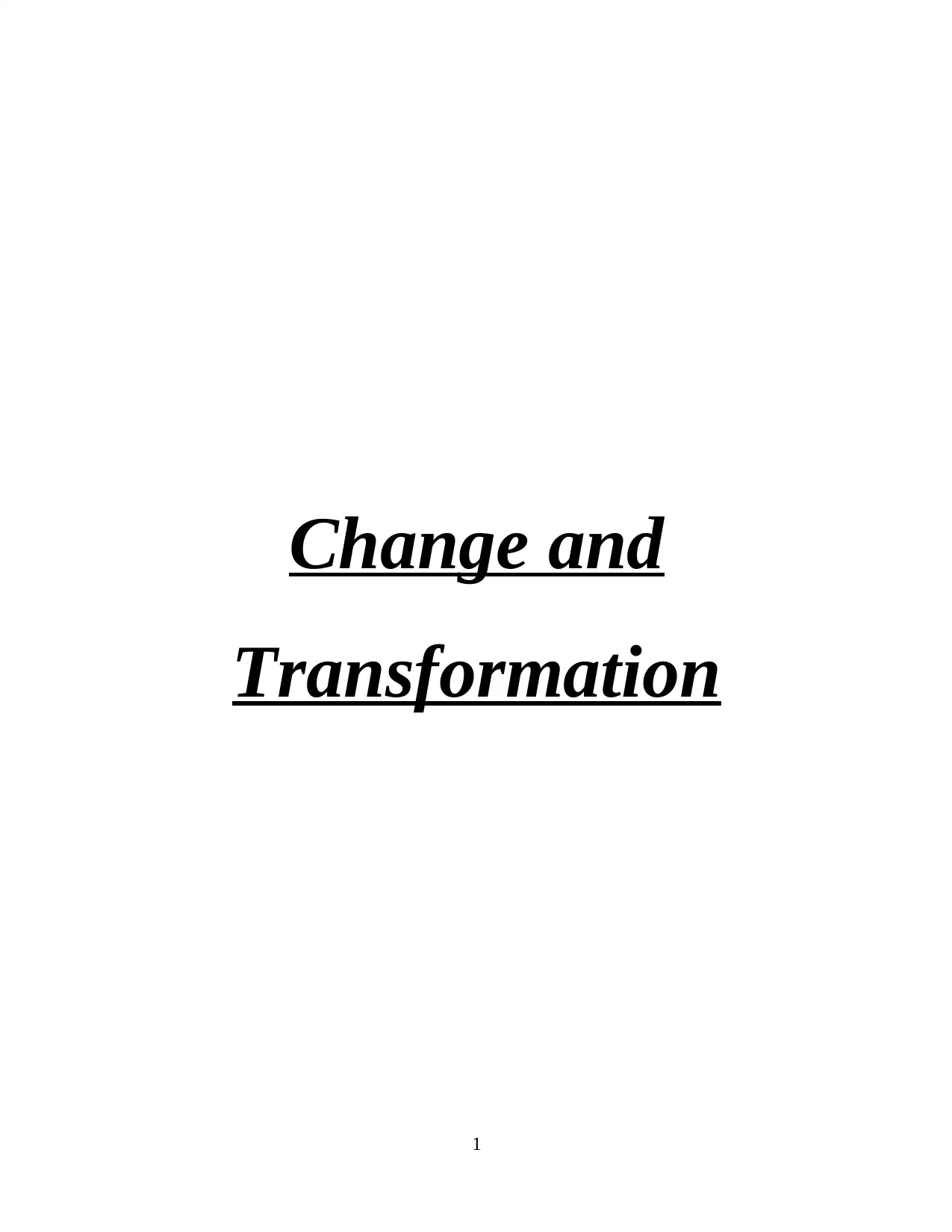
Change and
Transformation
1
Transformation
1
Paraphrase This Document
Need a fresh take? Get an instant paraphrase of this document with our AI Paraphraser
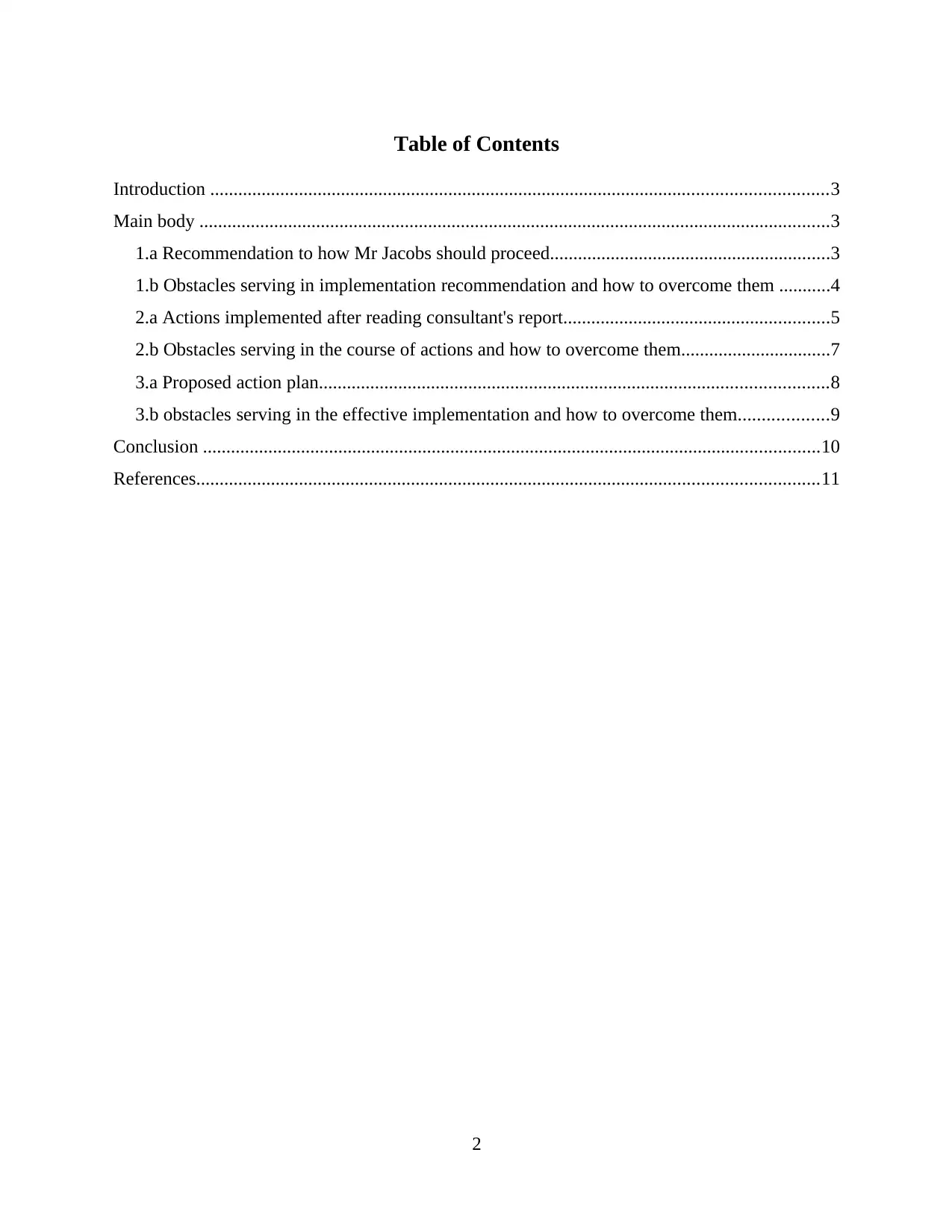
Table of Contents
Introduction ....................................................................................................................................3
Main body .......................................................................................................................................3
1.a Recommendation to how Mr Jacobs should proceed............................................................3
1.b Obstacles serving in implementation recommendation and how to overcome them ...........4
2.a Actions implemented after reading consultant's report.........................................................5
2.b Obstacles serving in the course of actions and how to overcome them................................7
3.a Proposed action plan.............................................................................................................8
3.b obstacles serving in the effective implementation and how to overcome them...................9
Conclusion ....................................................................................................................................10
References.....................................................................................................................................11
2
Introduction ....................................................................................................................................3
Main body .......................................................................................................................................3
1.a Recommendation to how Mr Jacobs should proceed............................................................3
1.b Obstacles serving in implementation recommendation and how to overcome them ...........4
2.a Actions implemented after reading consultant's report.........................................................5
2.b Obstacles serving in the course of actions and how to overcome them................................7
3.a Proposed action plan.............................................................................................................8
3.b obstacles serving in the effective implementation and how to overcome them...................9
Conclusion ....................................................................................................................................10
References.....................................................................................................................................11
2
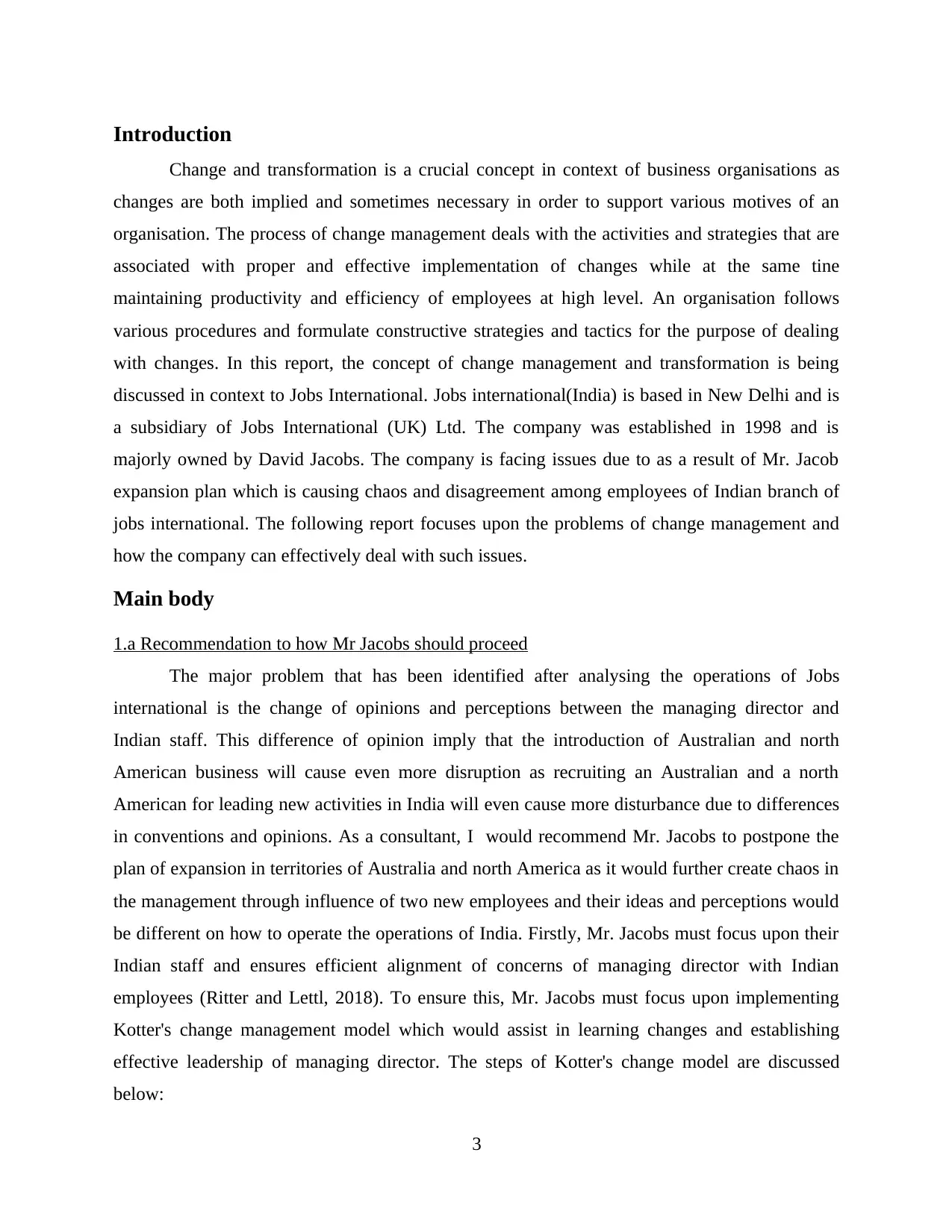
Introduction
Change and transformation is a crucial concept in context of business organisations as
changes are both implied and sometimes necessary in order to support various motives of an
organisation. The process of change management deals with the activities and strategies that are
associated with proper and effective implementation of changes while at the same tine
maintaining productivity and efficiency of employees at high level. An organisation follows
various procedures and formulate constructive strategies and tactics for the purpose of dealing
with changes. In this report, the concept of change management and transformation is being
discussed in context to Jobs International. Jobs international(India) is based in New Delhi and is
a subsidiary of Jobs International (UK) Ltd. The company was established in 1998 and is
majorly owned by David Jacobs. The company is facing issues due to as a result of Mr. Jacob
expansion plan which is causing chaos and disagreement among employees of Indian branch of
jobs international. The following report focuses upon the problems of change management and
how the company can effectively deal with such issues.
Main body
1.a Recommendation to how Mr Jacobs should proceed
The major problem that has been identified after analysing the operations of Jobs
international is the change of opinions and perceptions between the managing director and
Indian staff. This difference of opinion imply that the introduction of Australian and north
American business will cause even more disruption as recruiting an Australian and a north
American for leading new activities in India will even cause more disturbance due to differences
in conventions and opinions. As a consultant, I would recommend Mr. Jacobs to postpone the
plan of expansion in territories of Australia and north America as it would further create chaos in
the management through influence of two new employees and their ideas and perceptions would
be different on how to operate the operations of India. Firstly, Mr. Jacobs must focus upon their
Indian staff and ensures efficient alignment of concerns of managing director with Indian
employees (Ritter and Lettl, 2018). To ensure this, Mr. Jacobs must focus upon implementing
Kotter's change management model which would assist in learning changes and establishing
effective leadership of managing director. The steps of Kotter's change model are discussed
below:
3
Change and transformation is a crucial concept in context of business organisations as
changes are both implied and sometimes necessary in order to support various motives of an
organisation. The process of change management deals with the activities and strategies that are
associated with proper and effective implementation of changes while at the same tine
maintaining productivity and efficiency of employees at high level. An organisation follows
various procedures and formulate constructive strategies and tactics for the purpose of dealing
with changes. In this report, the concept of change management and transformation is being
discussed in context to Jobs International. Jobs international(India) is based in New Delhi and is
a subsidiary of Jobs International (UK) Ltd. The company was established in 1998 and is
majorly owned by David Jacobs. The company is facing issues due to as a result of Mr. Jacob
expansion plan which is causing chaos and disagreement among employees of Indian branch of
jobs international. The following report focuses upon the problems of change management and
how the company can effectively deal with such issues.
Main body
1.a Recommendation to how Mr Jacobs should proceed
The major problem that has been identified after analysing the operations of Jobs
international is the change of opinions and perceptions between the managing director and
Indian staff. This difference of opinion imply that the introduction of Australian and north
American business will cause even more disruption as recruiting an Australian and a north
American for leading new activities in India will even cause more disturbance due to differences
in conventions and opinions. As a consultant, I would recommend Mr. Jacobs to postpone the
plan of expansion in territories of Australia and north America as it would further create chaos in
the management through influence of two new employees and their ideas and perceptions would
be different on how to operate the operations of India. Firstly, Mr. Jacobs must focus upon their
Indian staff and ensures efficient alignment of concerns of managing director with Indian
employees (Ritter and Lettl, 2018). To ensure this, Mr. Jacobs must focus upon implementing
Kotter's change management model which would assist in learning changes and establishing
effective leadership of managing director. The steps of Kotter's change model are discussed
below:
3
⊘ This is a preview!⊘
Do you want full access?
Subscribe today to unlock all pages.

Trusted by 1+ million students worldwide
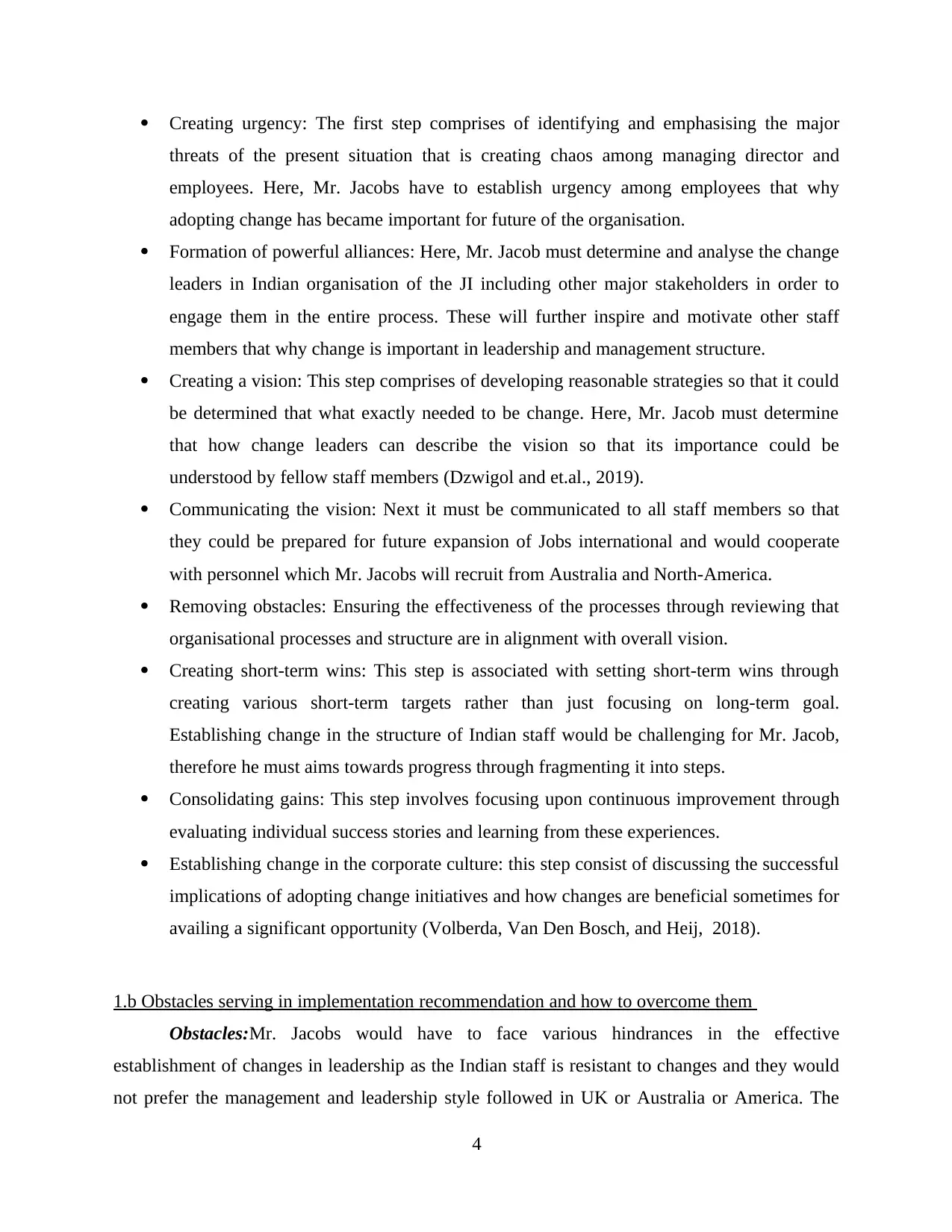
Creating urgency: The first step comprises of identifying and emphasising the major
threats of the present situation that is creating chaos among managing director and
employees. Here, Mr. Jacobs have to establish urgency among employees that why
adopting change has became important for future of the organisation.
Formation of powerful alliances: Here, Mr. Jacob must determine and analyse the change
leaders in Indian organisation of the JI including other major stakeholders in order to
engage them in the entire process. These will further inspire and motivate other staff
members that why change is important in leadership and management structure.
Creating a vision: This step comprises of developing reasonable strategies so that it could
be determined that what exactly needed to be change. Here, Mr. Jacob must determine
that how change leaders can describe the vision so that its importance could be
understood by fellow staff members (Dzwigol and et.al., 2019).
Communicating the vision: Next it must be communicated to all staff members so that
they could be prepared for future expansion of Jobs international and would cooperate
with personnel which Mr. Jacobs will recruit from Australia and North-America.
Removing obstacles: Ensuring the effectiveness of the processes through reviewing that
organisational processes and structure are in alignment with overall vision.
Creating short-term wins: This step is associated with setting short-term wins through
creating various short-term targets rather than just focusing on long-term goal.
Establishing change in the structure of Indian staff would be challenging for Mr. Jacob,
therefore he must aims towards progress through fragmenting it into steps.
Consolidating gains: This step involves focusing upon continuous improvement through
evaluating individual success stories and learning from these experiences.
Establishing change in the corporate culture: this step consist of discussing the successful
implications of adopting change initiatives and how changes are beneficial sometimes for
availing a significant opportunity (Volberda, Van Den Bosch, and Heij, 2018).
1.b Obstacles serving in implementation recommendation and how to overcome them
Obstacles:Mr. Jacobs would have to face various hindrances in the effective
establishment of changes in leadership as the Indian staff is resistant to changes and they would
not prefer the management and leadership style followed in UK or Australia or America. The
4
threats of the present situation that is creating chaos among managing director and
employees. Here, Mr. Jacobs have to establish urgency among employees that why
adopting change has became important for future of the organisation.
Formation of powerful alliances: Here, Mr. Jacob must determine and analyse the change
leaders in Indian organisation of the JI including other major stakeholders in order to
engage them in the entire process. These will further inspire and motivate other staff
members that why change is important in leadership and management structure.
Creating a vision: This step comprises of developing reasonable strategies so that it could
be determined that what exactly needed to be change. Here, Mr. Jacob must determine
that how change leaders can describe the vision so that its importance could be
understood by fellow staff members (Dzwigol and et.al., 2019).
Communicating the vision: Next it must be communicated to all staff members so that
they could be prepared for future expansion of Jobs international and would cooperate
with personnel which Mr. Jacobs will recruit from Australia and North-America.
Removing obstacles: Ensuring the effectiveness of the processes through reviewing that
organisational processes and structure are in alignment with overall vision.
Creating short-term wins: This step is associated with setting short-term wins through
creating various short-term targets rather than just focusing on long-term goal.
Establishing change in the structure of Indian staff would be challenging for Mr. Jacob,
therefore he must aims towards progress through fragmenting it into steps.
Consolidating gains: This step involves focusing upon continuous improvement through
evaluating individual success stories and learning from these experiences.
Establishing change in the corporate culture: this step consist of discussing the successful
implications of adopting change initiatives and how changes are beneficial sometimes for
availing a significant opportunity (Volberda, Van Den Bosch, and Heij, 2018).
1.b Obstacles serving in implementation recommendation and how to overcome them
Obstacles:Mr. Jacobs would have to face various hindrances in the effective
establishment of changes in leadership as the Indian staff is resistant to changes and they would
not prefer the management and leadership style followed in UK or Australia or America. The
4
Paraphrase This Document
Need a fresh take? Get an instant paraphrase of this document with our AI Paraphraser

organisational structure of the Indian operations is more conventional and hierarchical than other
similar companies which are operating in India. Their staff relies on instructions heavily and are
not tend to take initiative on their own. While developing and establishing change in managerial
and leadership structure which would be more focused towards professionalism, teamwork and
taking initiative from own. These aspects were previously resented by the staff of indian
operation and hence implementing changes in leadership style through focusing towards a
organisation structure followed in large UK based organisation is quite challenging as employees
are prone to show resistance to changes. Now these hindrances are multiplied when employees
get to know about Mr. Jacob's plan of expansion through slotting two new divisions, one for
Australia and one for North-America (DePamphilis, 2019).
Solutions: The problem of employees resentment and lack of support that has identified
while implementation of changes in leadership and managerial structure is due to the lack of
vision and effective communication. The steps that are explained above in the Kotter's change
management model would assist the overall process of implementing change effectively.
Implementing change could be practiced effectively when communicated properly through
growing awareness and stating why implying changes are important in the given context. Here,
Mr. Jacob would ensure the process of implying change in organisational structure through
developing understanding among employees that how changes would lead their company
towards growth and development (Ranta, Aarikka-Stenroos and Mäkinen, 2018). The expansion
to new territories will bring success to the organisation and therefore the emergence of changes
has created. Also, employees must be made aware that how changes become necessity
sometimes as per the given circumstances. Here, the circumstances are implying that changes
must be adopted for the purpose of constructive expansion. But before implementing the
expansion procedure, it is very important to aware staff members with the extension plan and
how it demands changes for successful projection.
2.a Actions implemented after reading consultant's report
The consultant's report has evaluated a range of problems and issues that has been
identified in the organisational structure and staff's perceptions which has caused a major
collision of ideas between managing director and staff members. Staff do not cooperate in
implementing changes and often shows resistance and resentment while introducing changes by
managing director. The report further stated that this is due to the fact that employees are
5
similar companies which are operating in India. Their staff relies on instructions heavily and are
not tend to take initiative on their own. While developing and establishing change in managerial
and leadership structure which would be more focused towards professionalism, teamwork and
taking initiative from own. These aspects were previously resented by the staff of indian
operation and hence implementing changes in leadership style through focusing towards a
organisation structure followed in large UK based organisation is quite challenging as employees
are prone to show resistance to changes. Now these hindrances are multiplied when employees
get to know about Mr. Jacob's plan of expansion through slotting two new divisions, one for
Australia and one for North-America (DePamphilis, 2019).
Solutions: The problem of employees resentment and lack of support that has identified
while implementation of changes in leadership and managerial structure is due to the lack of
vision and effective communication. The steps that are explained above in the Kotter's change
management model would assist the overall process of implementing change effectively.
Implementing change could be practiced effectively when communicated properly through
growing awareness and stating why implying changes are important in the given context. Here,
Mr. Jacob would ensure the process of implying change in organisational structure through
developing understanding among employees that how changes would lead their company
towards growth and development (Ranta, Aarikka-Stenroos and Mäkinen, 2018). The expansion
to new territories will bring success to the organisation and therefore the emergence of changes
has created. Also, employees must be made aware that how changes become necessity
sometimes as per the given circumstances. Here, the circumstances are implying that changes
must be adopted for the purpose of constructive expansion. But before implementing the
expansion procedure, it is very important to aware staff members with the extension plan and
how it demands changes for successful projection.
2.a Actions implemented after reading consultant's report
The consultant's report has evaluated a range of problems and issues that has been
identified in the organisational structure and staff's perceptions which has caused a major
collision of ideas between managing director and staff members. Staff do not cooperate in
implementing changes and often shows resistance and resentment while introducing changes by
managing director. The report further stated that this is due to the fact that employees are
5
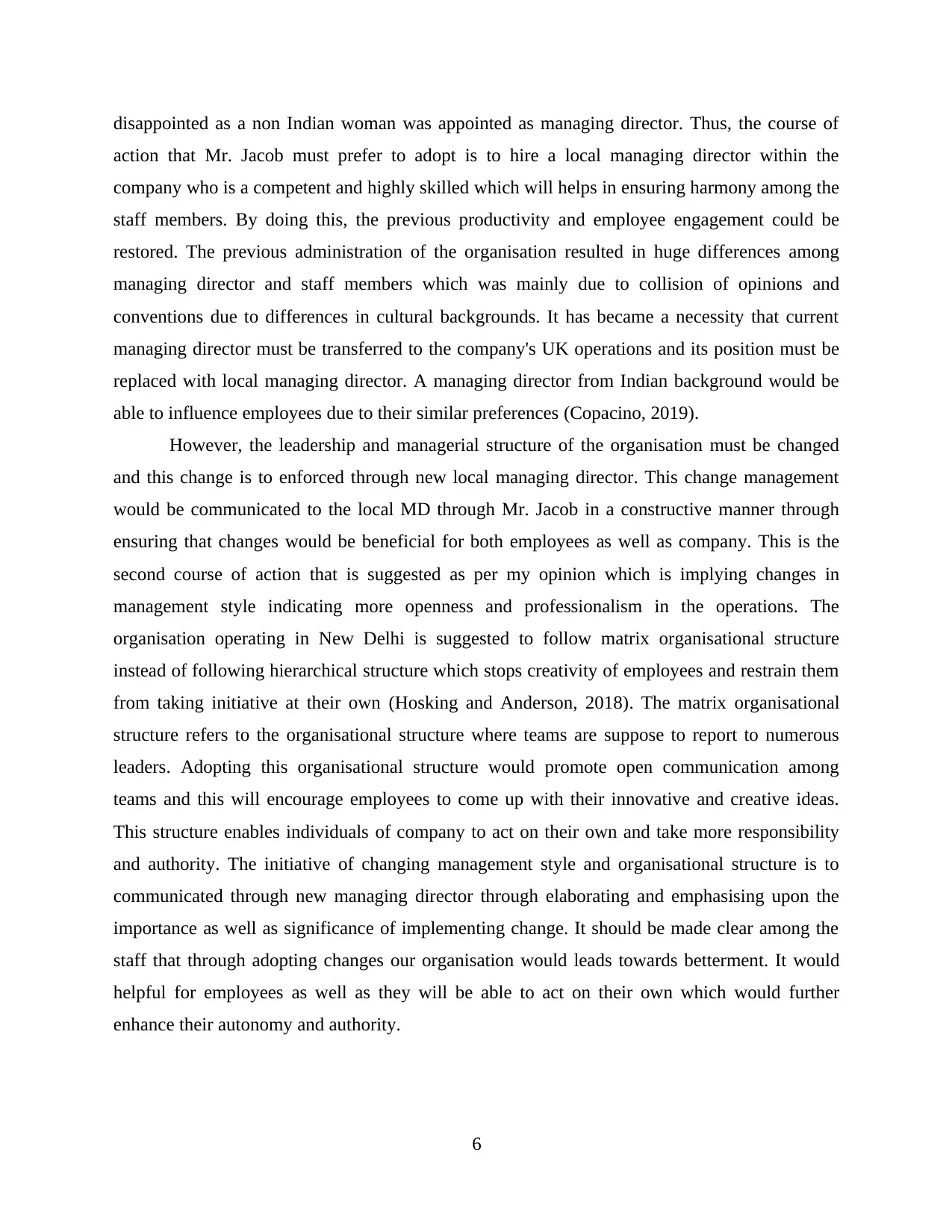
disappointed as a non Indian woman was appointed as managing director. Thus, the course of
action that Mr. Jacob must prefer to adopt is to hire a local managing director within the
company who is a competent and highly skilled which will helps in ensuring harmony among the
staff members. By doing this, the previous productivity and employee engagement could be
restored. The previous administration of the organisation resulted in huge differences among
managing director and staff members which was mainly due to collision of opinions and
conventions due to differences in cultural backgrounds. It has became a necessity that current
managing director must be transferred to the company's UK operations and its position must be
replaced with local managing director. A managing director from Indian background would be
able to influence employees due to their similar preferences (Copacino, 2019).
However, the leadership and managerial structure of the organisation must be changed
and this change is to enforced through new local managing director. This change management
would be communicated to the local MD through Mr. Jacob in a constructive manner through
ensuring that changes would be beneficial for both employees as well as company. This is the
second course of action that is suggested as per my opinion which is implying changes in
management style indicating more openness and professionalism in the operations. The
organisation operating in New Delhi is suggested to follow matrix organisational structure
instead of following hierarchical structure which stops creativity of employees and restrain them
from taking initiative at their own (Hosking and Anderson, 2018). The matrix organisational
structure refers to the organisational structure where teams are suppose to report to numerous
leaders. Adopting this organisational structure would promote open communication among
teams and this will encourage employees to come up with their innovative and creative ideas.
This structure enables individuals of company to act on their own and take more responsibility
and authority. The initiative of changing management style and organisational structure is to
communicated through new managing director through elaborating and emphasising upon the
importance as well as significance of implementing change. It should be made clear among the
staff that through adopting changes our organisation would leads towards betterment. It would
helpful for employees as well as they will be able to act on their own which would further
enhance their autonomy and authority.
6
action that Mr. Jacob must prefer to adopt is to hire a local managing director within the
company who is a competent and highly skilled which will helps in ensuring harmony among the
staff members. By doing this, the previous productivity and employee engagement could be
restored. The previous administration of the organisation resulted in huge differences among
managing director and staff members which was mainly due to collision of opinions and
conventions due to differences in cultural backgrounds. It has became a necessity that current
managing director must be transferred to the company's UK operations and its position must be
replaced with local managing director. A managing director from Indian background would be
able to influence employees due to their similar preferences (Copacino, 2019).
However, the leadership and managerial structure of the organisation must be changed
and this change is to enforced through new local managing director. This change management
would be communicated to the local MD through Mr. Jacob in a constructive manner through
ensuring that changes would be beneficial for both employees as well as company. This is the
second course of action that is suggested as per my opinion which is implying changes in
management style indicating more openness and professionalism in the operations. The
organisation operating in New Delhi is suggested to follow matrix organisational structure
instead of following hierarchical structure which stops creativity of employees and restrain them
from taking initiative at their own (Hosking and Anderson, 2018). The matrix organisational
structure refers to the organisational structure where teams are suppose to report to numerous
leaders. Adopting this organisational structure would promote open communication among
teams and this will encourage employees to come up with their innovative and creative ideas.
This structure enables individuals of company to act on their own and take more responsibility
and authority. The initiative of changing management style and organisational structure is to
communicated through new managing director through elaborating and emphasising upon the
importance as well as significance of implementing change. It should be made clear among the
staff that through adopting changes our organisation would leads towards betterment. It would
helpful for employees as well as they will be able to act on their own which would further
enhance their autonomy and authority.
6
⊘ This is a preview!⊘
Do you want full access?
Subscribe today to unlock all pages.

Trusted by 1+ million students worldwide

2.b Obstacles serving in the course of actions and how to overcome them
Obstacles: The change in the organisation is advantageous for the organization to
enhance its efficiency power as well as optimising business activities in the correct manner.
However, there can be certain obstruction that can arise in the course of deploying change
initiatives in the company. In context to Jobs International company, the firm can face certain
challenges in order to successfully implement their change initiatives. The following are the
problems that can arise in the Jobs international firm are: Employee opposition to change: The resistance behaviour of workers of the company
can be a big factor in hampering the change initiatives of the organisation. The personnel
can refuse the change regarding moving to international markets as they prefers an Indian
senior managers more than the English man. In addition to this, the worker of the
company are taking less initiatives as well as they also stopped taking duties for higher
position (Jabbour and et.al., 2019). This can prevent the firm in introducing effective
change in the company. Furthermore, the deficiency of professionalism among Indian
staff unit are also major element that can pose a barrier in front of change initiatives of
company. Lack of communication: The lack of communication due to conventional organisational
structure of the organisation can also be powerful factor in poor adoption of change
initiatives. The hierarchical structure forces the worker to not perform on the basis of
their own initiatives rather have to wait for their task to perform. In addition to this, the
lack of team building culture can also hamper the establishment of growth strategies.
Cultural barriers: The deviation in culture between India as well as UK is also reasoned
as the major trouble that can arise in the course of successful execution of change
strategies. Due to the cultural variation, the Indian people have different belief as well as
behaviour from the UK people. This alteration in decision making styles as well as task
execution can challenge the company in successfully implementing their change
strategies.
Solutions: The organization can cut down the fear of employees regarding accepting
change by selecting the senior managers from Indian country only as this will hike their
engagement level in the management decisions (Myers, 2019). In relation to this, the firm can
also motivate the worker in order to accept change for moving to Australia as well as north
7
Obstacles: The change in the organisation is advantageous for the organization to
enhance its efficiency power as well as optimising business activities in the correct manner.
However, there can be certain obstruction that can arise in the course of deploying change
initiatives in the company. In context to Jobs International company, the firm can face certain
challenges in order to successfully implement their change initiatives. The following are the
problems that can arise in the Jobs international firm are: Employee opposition to change: The resistance behaviour of workers of the company
can be a big factor in hampering the change initiatives of the organisation. The personnel
can refuse the change regarding moving to international markets as they prefers an Indian
senior managers more than the English man. In addition to this, the worker of the
company are taking less initiatives as well as they also stopped taking duties for higher
position (Jabbour and et.al., 2019). This can prevent the firm in introducing effective
change in the company. Furthermore, the deficiency of professionalism among Indian
staff unit are also major element that can pose a barrier in front of change initiatives of
company. Lack of communication: The lack of communication due to conventional organisational
structure of the organisation can also be powerful factor in poor adoption of change
initiatives. The hierarchical structure forces the worker to not perform on the basis of
their own initiatives rather have to wait for their task to perform. In addition to this, the
lack of team building culture can also hamper the establishment of growth strategies.
Cultural barriers: The deviation in culture between India as well as UK is also reasoned
as the major trouble that can arise in the course of successful execution of change
strategies. Due to the cultural variation, the Indian people have different belief as well as
behaviour from the UK people. This alteration in decision making styles as well as task
execution can challenge the company in successfully implementing their change
strategies.
Solutions: The organization can cut down the fear of employees regarding accepting
change by selecting the senior managers from Indian country only as this will hike their
engagement level in the management decisions (Myers, 2019). In relation to this, the firm can
also motivate the worker in order to accept change for moving to Australia as well as north
7
Paraphrase This Document
Need a fresh take? Get an instant paraphrase of this document with our AI Paraphraser
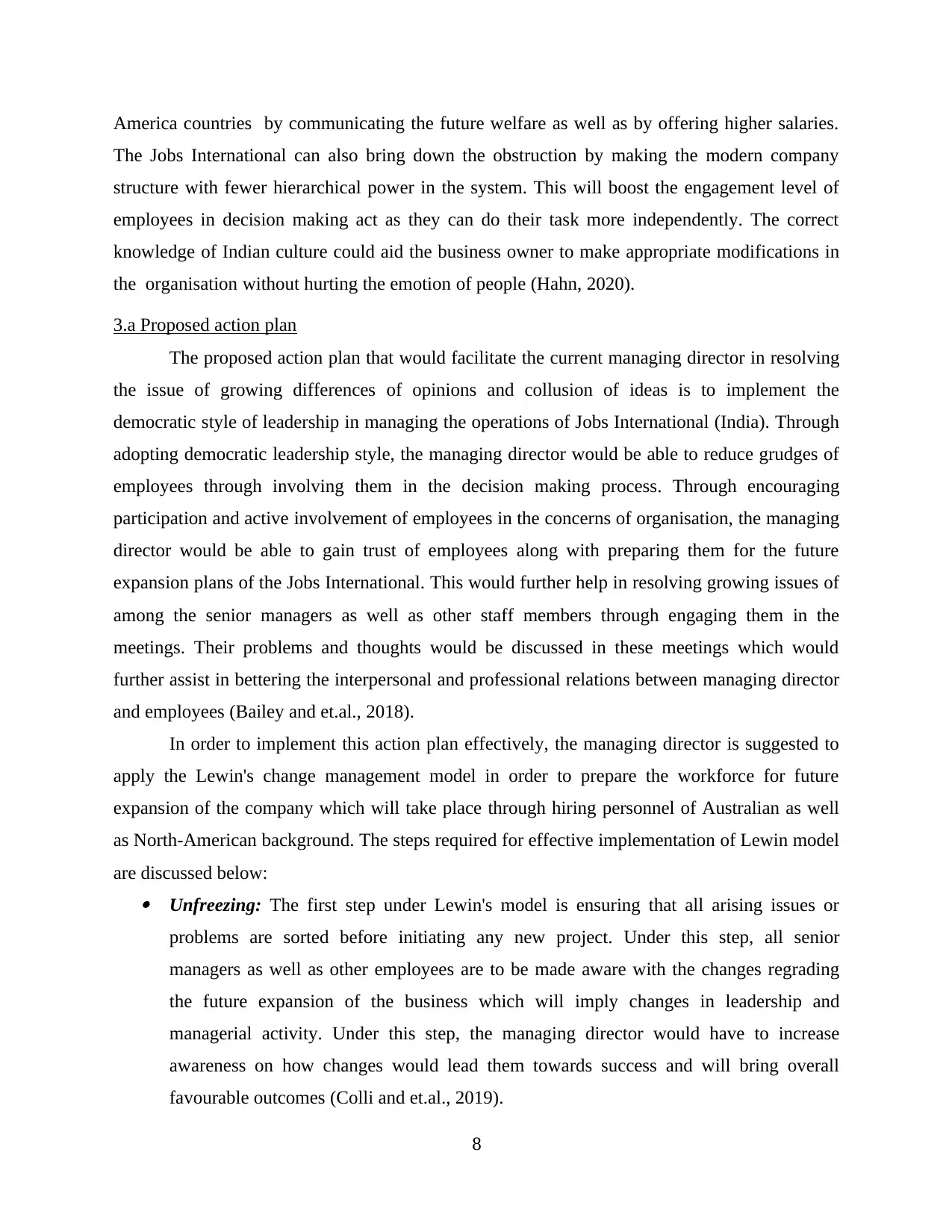
America countries by communicating the future welfare as well as by offering higher salaries.
The Jobs International can also bring down the obstruction by making the modern company
structure with fewer hierarchical power in the system. This will boost the engagement level of
employees in decision making act as they can do their task more independently. The correct
knowledge of Indian culture could aid the business owner to make appropriate modifications in
the organisation without hurting the emotion of people (Hahn, 2020).
3.a Proposed action plan
The proposed action plan that would facilitate the current managing director in resolving
the issue of growing differences of opinions and collusion of ideas is to implement the
democratic style of leadership in managing the operations of Jobs International (India). Through
adopting democratic leadership style, the managing director would be able to reduce grudges of
employees through involving them in the decision making process. Through encouraging
participation and active involvement of employees in the concerns of organisation, the managing
director would be able to gain trust of employees along with preparing them for the future
expansion plans of the Jobs International. This would further help in resolving growing issues of
among the senior managers as well as other staff members through engaging them in the
meetings. Their problems and thoughts would be discussed in these meetings which would
further assist in bettering the interpersonal and professional relations between managing director
and employees (Bailey and et.al., 2018).
In order to implement this action plan effectively, the managing director is suggested to
apply the Lewin's change management model in order to prepare the workforce for future
expansion of the company which will take place through hiring personnel of Australian as well
as North-American background. The steps required for effective implementation of Lewin model
are discussed below: Unfreezing: The first step under Lewin's model is ensuring that all arising issues or
problems are sorted before initiating any new project. Under this step, all senior
managers as well as other employees are to be made aware with the changes regrading
the future expansion of the business which will imply changes in leadership and
managerial activity. Under this step, the managing director would have to increase
awareness on how changes would lead them towards success and will bring overall
favourable outcomes (Colli and et.al., 2019).
8
The Jobs International can also bring down the obstruction by making the modern company
structure with fewer hierarchical power in the system. This will boost the engagement level of
employees in decision making act as they can do their task more independently. The correct
knowledge of Indian culture could aid the business owner to make appropriate modifications in
the organisation without hurting the emotion of people (Hahn, 2020).
3.a Proposed action plan
The proposed action plan that would facilitate the current managing director in resolving
the issue of growing differences of opinions and collusion of ideas is to implement the
democratic style of leadership in managing the operations of Jobs International (India). Through
adopting democratic leadership style, the managing director would be able to reduce grudges of
employees through involving them in the decision making process. Through encouraging
participation and active involvement of employees in the concerns of organisation, the managing
director would be able to gain trust of employees along with preparing them for the future
expansion plans of the Jobs International. This would further help in resolving growing issues of
among the senior managers as well as other staff members through engaging them in the
meetings. Their problems and thoughts would be discussed in these meetings which would
further assist in bettering the interpersonal and professional relations between managing director
and employees (Bailey and et.al., 2018).
In order to implement this action plan effectively, the managing director is suggested to
apply the Lewin's change management model in order to prepare the workforce for future
expansion of the company which will take place through hiring personnel of Australian as well
as North-American background. The steps required for effective implementation of Lewin model
are discussed below: Unfreezing: The first step under Lewin's model is ensuring that all arising issues or
problems are sorted before initiating any new project. Under this step, all senior
managers as well as other employees are to be made aware with the changes regrading
the future expansion of the business which will imply changes in leadership and
managerial activity. Under this step, the managing director would have to increase
awareness on how changes would lead them towards success and will bring overall
favourable outcomes (Colli and et.al., 2019).
8
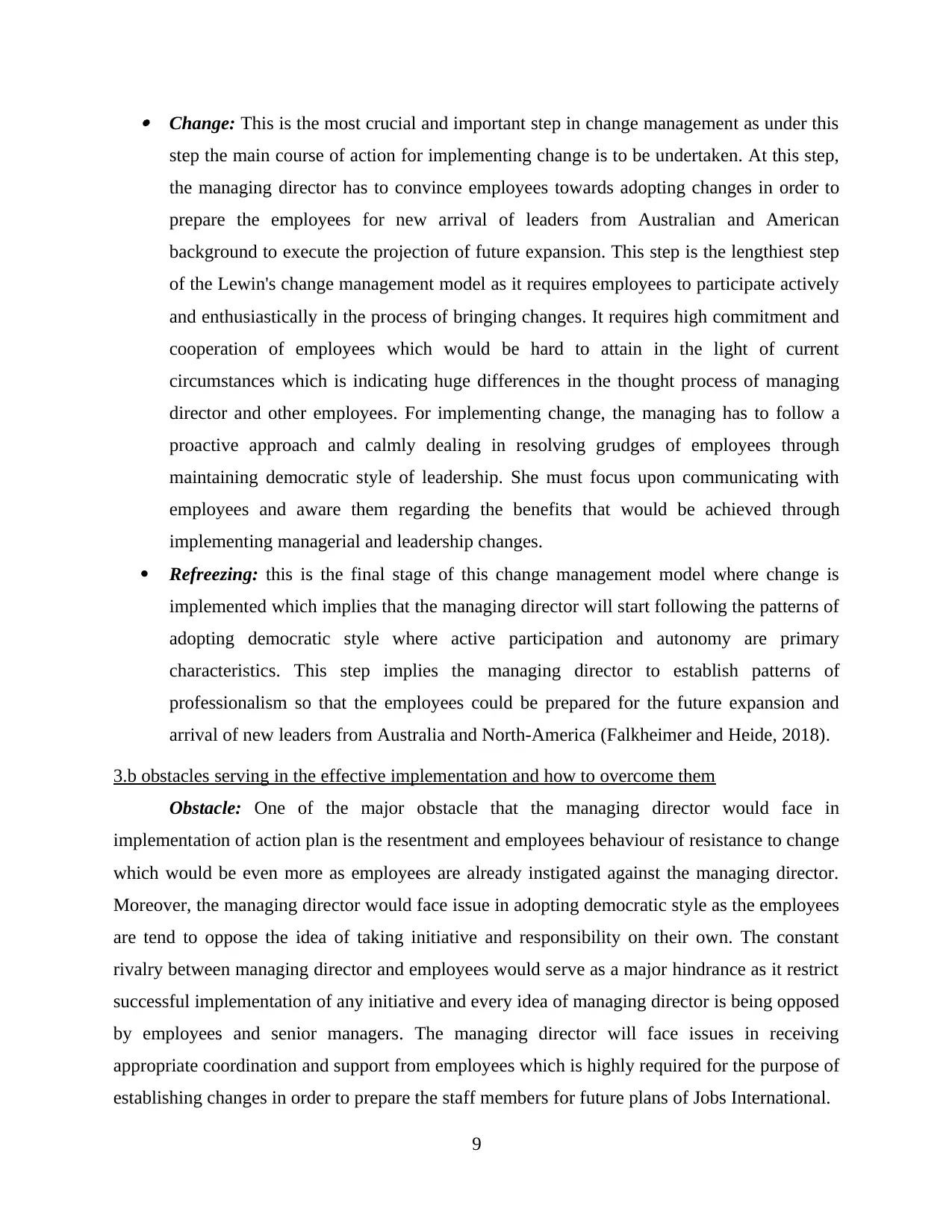
Change: This is the most crucial and important step in change management as under this
step the main course of action for implementing change is to be undertaken. At this step,
the managing director has to convince employees towards adopting changes in order to
prepare the employees for new arrival of leaders from Australian and American
background to execute the projection of future expansion. This step is the lengthiest step
of the Lewin's change management model as it requires employees to participate actively
and enthusiastically in the process of bringing changes. It requires high commitment and
cooperation of employees which would be hard to attain in the light of current
circumstances which is indicating huge differences in the thought process of managing
director and other employees. For implementing change, the managing has to follow a
proactive approach and calmly dealing in resolving grudges of employees through
maintaining democratic style of leadership. She must focus upon communicating with
employees and aware them regarding the benefits that would be achieved through
implementing managerial and leadership changes.
Refreezing: this is the final stage of this change management model where change is
implemented which implies that the managing director will start following the patterns of
adopting democratic style where active participation and autonomy are primary
characteristics. This step implies the managing director to establish patterns of
professionalism so that the employees could be prepared for the future expansion and
arrival of new leaders from Australia and North-America (Falkheimer and Heide, 2018).
3.b obstacles serving in the effective implementation and how to overcome them
Obstacle: One of the major obstacle that the managing director would face in
implementation of action plan is the resentment and employees behaviour of resistance to change
which would be even more as employees are already instigated against the managing director.
Moreover, the managing director would face issue in adopting democratic style as the employees
are tend to oppose the idea of taking initiative and responsibility on their own. The constant
rivalry between managing director and employees would serve as a major hindrance as it restrict
successful implementation of any initiative and every idea of managing director is being opposed
by employees and senior managers. The managing director will face issues in receiving
appropriate coordination and support from employees which is highly required for the purpose of
establishing changes in order to prepare the staff members for future plans of Jobs International.
9
step the main course of action for implementing change is to be undertaken. At this step,
the managing director has to convince employees towards adopting changes in order to
prepare the employees for new arrival of leaders from Australian and American
background to execute the projection of future expansion. This step is the lengthiest step
of the Lewin's change management model as it requires employees to participate actively
and enthusiastically in the process of bringing changes. It requires high commitment and
cooperation of employees which would be hard to attain in the light of current
circumstances which is indicating huge differences in the thought process of managing
director and other employees. For implementing change, the managing has to follow a
proactive approach and calmly dealing in resolving grudges of employees through
maintaining democratic style of leadership. She must focus upon communicating with
employees and aware them regarding the benefits that would be achieved through
implementing managerial and leadership changes.
Refreezing: this is the final stage of this change management model where change is
implemented which implies that the managing director will start following the patterns of
adopting democratic style where active participation and autonomy are primary
characteristics. This step implies the managing director to establish patterns of
professionalism so that the employees could be prepared for the future expansion and
arrival of new leaders from Australia and North-America (Falkheimer and Heide, 2018).
3.b obstacles serving in the effective implementation and how to overcome them
Obstacle: One of the major obstacle that the managing director would face in
implementation of action plan is the resentment and employees behaviour of resistance to change
which would be even more as employees are already instigated against the managing director.
Moreover, the managing director would face issue in adopting democratic style as the employees
are tend to oppose the idea of taking initiative and responsibility on their own. The constant
rivalry between managing director and employees would serve as a major hindrance as it restrict
successful implementation of any initiative and every idea of managing director is being opposed
by employees and senior managers. The managing director will face issues in receiving
appropriate coordination and support from employees which is highly required for the purpose of
establishing changes in order to prepare the staff members for future plans of Jobs International.
9
⊘ This is a preview!⊘
Do you want full access?
Subscribe today to unlock all pages.

Trusted by 1+ million students worldwide
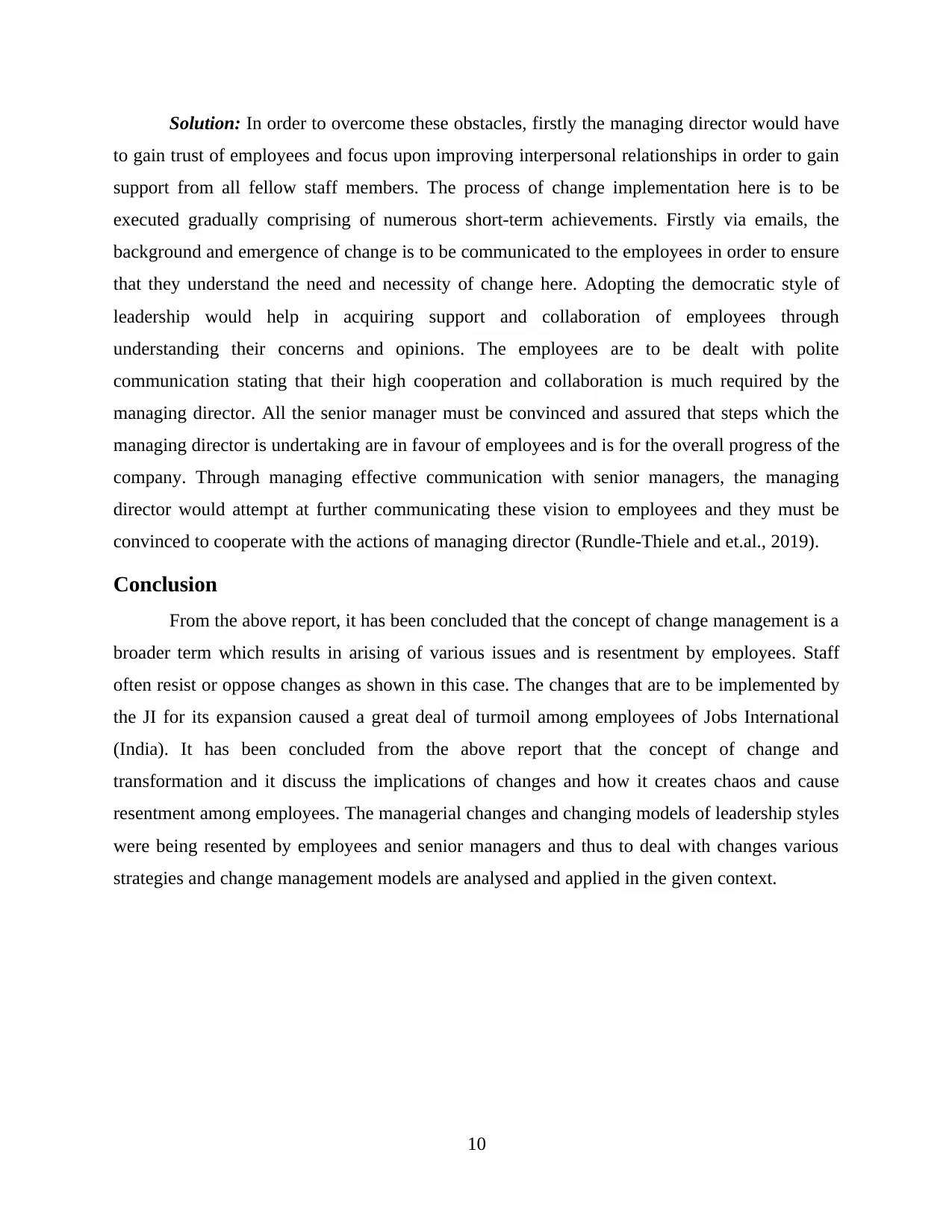
Solution: In order to overcome these obstacles, firstly the managing director would have
to gain trust of employees and focus upon improving interpersonal relationships in order to gain
support from all fellow staff members. The process of change implementation here is to be
executed gradually comprising of numerous short-term achievements. Firstly via emails, the
background and emergence of change is to be communicated to the employees in order to ensure
that they understand the need and necessity of change here. Adopting the democratic style of
leadership would help in acquiring support and collaboration of employees through
understanding their concerns and opinions. The employees are to be dealt with polite
communication stating that their high cooperation and collaboration is much required by the
managing director. All the senior manager must be convinced and assured that steps which the
managing director is undertaking are in favour of employees and is for the overall progress of the
company. Through managing effective communication with senior managers, the managing
director would attempt at further communicating these vision to employees and they must be
convinced to cooperate with the actions of managing director (Rundle-Thiele and et.al., 2019).
Conclusion
From the above report, it has been concluded that the concept of change management is a
broader term which results in arising of various issues and is resentment by employees. Staff
often resist or oppose changes as shown in this case. The changes that are to be implemented by
the JI for its expansion caused a great deal of turmoil among employees of Jobs International
(India). It has been concluded from the above report that the concept of change and
transformation and it discuss the implications of changes and how it creates chaos and cause
resentment among employees. The managerial changes and changing models of leadership styles
were being resented by employees and senior managers and thus to deal with changes various
strategies and change management models are analysed and applied in the given context.
10
to gain trust of employees and focus upon improving interpersonal relationships in order to gain
support from all fellow staff members. The process of change implementation here is to be
executed gradually comprising of numerous short-term achievements. Firstly via emails, the
background and emergence of change is to be communicated to the employees in order to ensure
that they understand the need and necessity of change here. Adopting the democratic style of
leadership would help in acquiring support and collaboration of employees through
understanding their concerns and opinions. The employees are to be dealt with polite
communication stating that their high cooperation and collaboration is much required by the
managing director. All the senior manager must be convinced and assured that steps which the
managing director is undertaking are in favour of employees and is for the overall progress of the
company. Through managing effective communication with senior managers, the managing
director would attempt at further communicating these vision to employees and they must be
convinced to cooperate with the actions of managing director (Rundle-Thiele and et.al., 2019).
Conclusion
From the above report, it has been concluded that the concept of change management is a
broader term which results in arising of various issues and is resentment by employees. Staff
often resist or oppose changes as shown in this case. The changes that are to be implemented by
the JI for its expansion caused a great deal of turmoil among employees of Jobs International
(India). It has been concluded from the above report that the concept of change and
transformation and it discuss the implications of changes and how it creates chaos and cause
resentment among employees. The managerial changes and changing models of leadership styles
were being resented by employees and senior managers and thus to deal with changes various
strategies and change management models are analysed and applied in the given context.
10
Paraphrase This Document
Need a fresh take? Get an instant paraphrase of this document with our AI Paraphraser
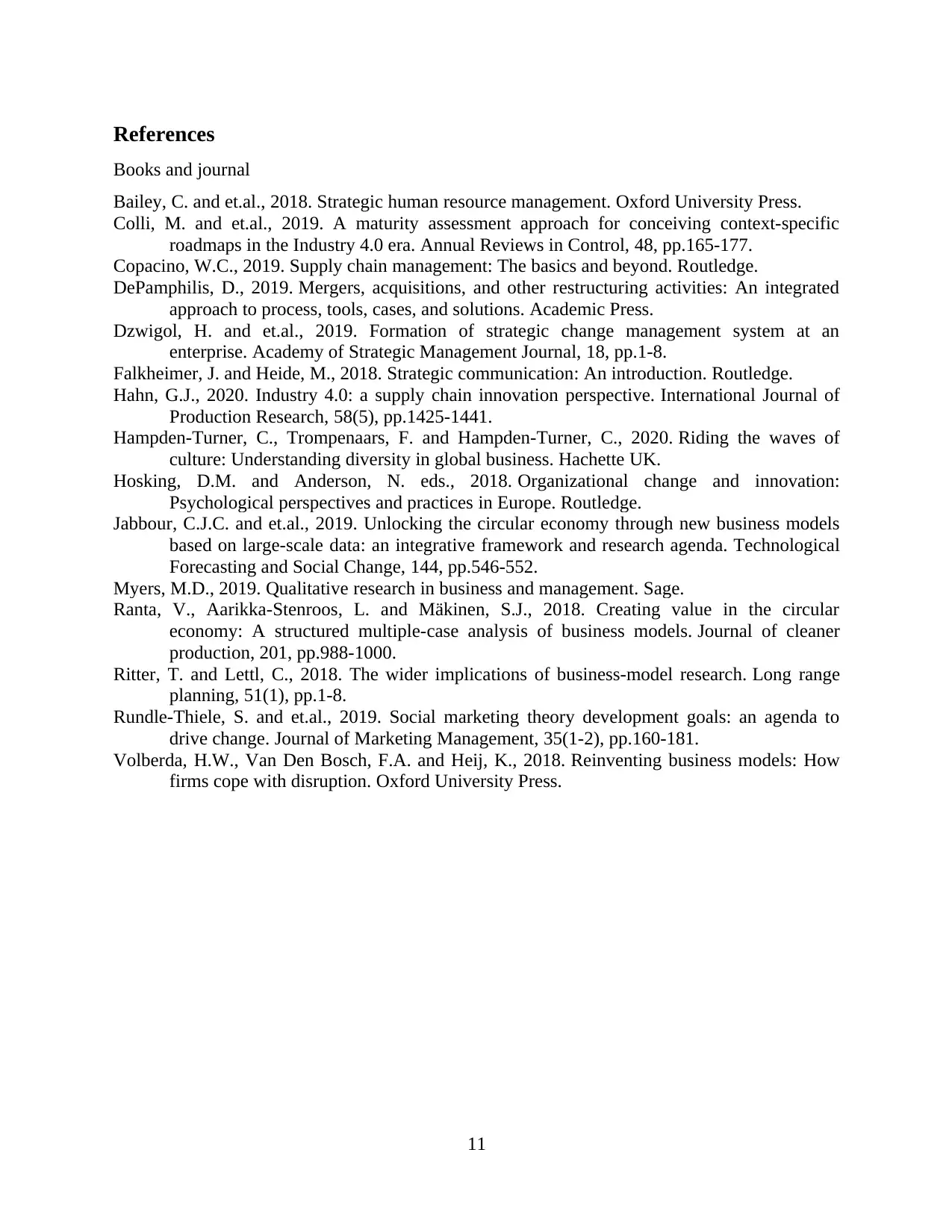
References
Books and journal
Bailey, C. and et.al., 2018. Strategic human resource management. Oxford University Press.
Colli, M. and et.al., 2019. A maturity assessment approach for conceiving context-specific
roadmaps in the Industry 4.0 era. Annual Reviews in Control, 48, pp.165-177.
Copacino, W.C., 2019. Supply chain management: The basics and beyond. Routledge.
DePamphilis, D., 2019. Mergers, acquisitions, and other restructuring activities: An integrated
approach to process, tools, cases, and solutions. Academic Press.
Dzwigol, H. and et.al., 2019. Formation of strategic change management system at an
enterprise. Academy of Strategic Management Journal, 18, pp.1-8.
Falkheimer, J. and Heide, M., 2018. Strategic communication: An introduction. Routledge.
Hahn, G.J., 2020. Industry 4.0: a supply chain innovation perspective. International Journal of
Production Research, 58(5), pp.1425-1441.
Hampden-Turner, C., Trompenaars, F. and Hampden-Turner, C., 2020. Riding the waves of
culture: Understanding diversity in global business. Hachette UK.
Hosking, D.M. and Anderson, N. eds., 2018. Organizational change and innovation:
Psychological perspectives and practices in Europe. Routledge.
Jabbour, C.J.C. and et.al., 2019. Unlocking the circular economy through new business models
based on large-scale data: an integrative framework and research agenda. Technological
Forecasting and Social Change, 144, pp.546-552.
Myers, M.D., 2019. Qualitative research in business and management. Sage.
Ranta, V., Aarikka-Stenroos, L. and Mäkinen, S.J., 2018. Creating value in the circular
economy: A structured multiple-case analysis of business models. Journal of cleaner
production, 201, pp.988-1000.
Ritter, T. and Lettl, C., 2018. The wider implications of business-model research. Long range
planning, 51(1), pp.1-8.
Rundle-Thiele, S. and et.al., 2019. Social marketing theory development goals: an agenda to
drive change. Journal of Marketing Management, 35(1-2), pp.160-181.
Volberda, H.W., Van Den Bosch, F.A. and Heij, K., 2018. Reinventing business models: How
firms cope with disruption. Oxford University Press.
11
Books and journal
Bailey, C. and et.al., 2018. Strategic human resource management. Oxford University Press.
Colli, M. and et.al., 2019. A maturity assessment approach for conceiving context-specific
roadmaps in the Industry 4.0 era. Annual Reviews in Control, 48, pp.165-177.
Copacino, W.C., 2019. Supply chain management: The basics and beyond. Routledge.
DePamphilis, D., 2019. Mergers, acquisitions, and other restructuring activities: An integrated
approach to process, tools, cases, and solutions. Academic Press.
Dzwigol, H. and et.al., 2019. Formation of strategic change management system at an
enterprise. Academy of Strategic Management Journal, 18, pp.1-8.
Falkheimer, J. and Heide, M., 2018. Strategic communication: An introduction. Routledge.
Hahn, G.J., 2020. Industry 4.0: a supply chain innovation perspective. International Journal of
Production Research, 58(5), pp.1425-1441.
Hampden-Turner, C., Trompenaars, F. and Hampden-Turner, C., 2020. Riding the waves of
culture: Understanding diversity in global business. Hachette UK.
Hosking, D.M. and Anderson, N. eds., 2018. Organizational change and innovation:
Psychological perspectives and practices in Europe. Routledge.
Jabbour, C.J.C. and et.al., 2019. Unlocking the circular economy through new business models
based on large-scale data: an integrative framework and research agenda. Technological
Forecasting and Social Change, 144, pp.546-552.
Myers, M.D., 2019. Qualitative research in business and management. Sage.
Ranta, V., Aarikka-Stenroos, L. and Mäkinen, S.J., 2018. Creating value in the circular
economy: A structured multiple-case analysis of business models. Journal of cleaner
production, 201, pp.988-1000.
Ritter, T. and Lettl, C., 2018. The wider implications of business-model research. Long range
planning, 51(1), pp.1-8.
Rundle-Thiele, S. and et.al., 2019. Social marketing theory development goals: an agenda to
drive change. Journal of Marketing Management, 35(1-2), pp.160-181.
Volberda, H.W., Van Den Bosch, F.A. and Heij, K., 2018. Reinventing business models: How
firms cope with disruption. Oxford University Press.
11
1 out of 11
Related Documents
Your All-in-One AI-Powered Toolkit for Academic Success.
+13062052269
info@desklib.com
Available 24*7 on WhatsApp / Email
![[object Object]](/_next/static/media/star-bottom.7253800d.svg)
Unlock your academic potential
Copyright © 2020–2025 A2Z Services. All Rights Reserved. Developed and managed by ZUCOL.





